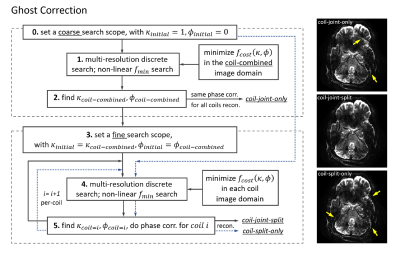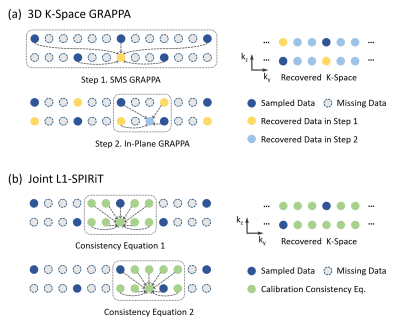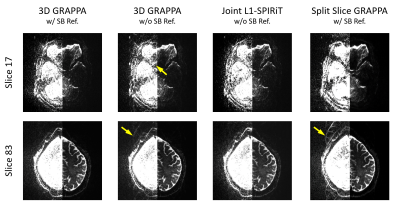0983
Coil-joint-split N/2 Ghost Correction and Joint L1-SPIRiT for SMS-EPI Reconstruction: Demonstration Using 7T HCP-style Diffusion Acquisition1Center for Biomedical Imaging Research, Department of Biomedical Engineering, School of Medicine, Tsinghua University, Beijing, China, 2Department of Radiology, Stanford University, Stanford, CA, United States, 3Center for Magnetic Resonance Research, Radiology, Medical School of the University of Minnesota, Minneapolis, MN, United States
Synopsis
Simultaneous Multislice (SMS) has become a major acceleration technique in Human Connectome Project (HCP) to acquire high-resolution diffusion and functional MRI. Conventional reconstruction for SMS-EPI includes using traditional Nyquist ghost correction and slice GRAPPA that usually requires single-band (SB) reference scans. In this work, we introducea a novel reference-less Nyquist ghost correction approach and a new joint L1-spirit reconstruction algorithm without the need of SB reference scans. We evaluated the performance of the proposed method by acquiring 7T HCP-style diffusion and show that the proposed method can effectively suppress the strong residual aliasing/ghosting as observed for when using conventional reconstruction.
Introduction
Simultaneous multislice (SMS) EPI (SMS-EPI)1,2 has great utility for rapid acquisition of neuroimaging at high and ultrahigh fields. Indeed, it serves as a workhorse imaging method in the original Human Connectome Project (HCP)3 to acquire high-resolution diffusion and functional MRI in a large cohort at both 3T and 7T. Conventional image reconstruction for SMS-EPI includes using traditional Nyquist ghost correction methods and slice GRAPPA2 that usually requires single-band (SB) reference scans for ensuring reconstruction performance4.Here we propose a novel reconstruction method that does not require SB reference scans while still producing quality images. The proposed method is built by the developments of a novel reference-less Nyquist ghost correction approach and a new joint L1-spirit reconstruction algorithm. We evaluated the performance by acquiring 7T HCP-style diffusion and show that the proposed method can effectively suppress the strong residual aliasing/ghosting as observed for when using conventional reconstruction.
Methods
Two-stage Coil-joint-split Ghost CorrectionThe new ghost correction consists of two stages (Fig. 1): 1) coil-joint and 2) coil-split phase correction, both modeling the ghost as a linear phase error and minimize a cost function defined by image entropy5. The first stage estimates the phase error in a coil-joint manner by using coil-combined images. Using the estimation from the first stage as an initial point and setting a refined search space, the second stage corrects the phase error for each coil in a coil-split manner (i.e. considering images of each coil separately).
Our result (Fig. 1) shows the proposed method can lead to visually ghosting-free images when incorporated into SMS-EPI reconstruction using conventional 3D GRAPPA6 with SB reference scans. Here, using only one of the two stages as an alternative for phase correction resulted in noticeable image artifacts, highlighting the importance of conducting both stages.
We note that the proposed ghost correction is a reference-less method since it does not rely on additional reference scan (e.g., the standard 3-line navigator) as required by most conventional methods.
Joint L1-SPIRiT in 3D k-space
The novel reconstruction proposed is based on a generalized concept that SMS-EPI acquisition with blipped-CAIPI can be viewed as under-sampled 3D k-space7 (Fig. 2). Unlike conventional 3D GRAPPA which recovers missing data for the two phase-encode (PE) directions in two separate steps, our reconstruction simultaneously estimates missing data in both PE directions.
This is done by enforcing consistency across both sampled and estimated k-space and by exploiting gradient sparsity8,9. The image reconstruction problem is formulated as: $$\min_{x}\parallel(G-I)\ x\parallel_{2}^{2}+\lambda\parallel\triangledown F^{-1}x\parallel_{1}\ \ s.t.\ Dx=y$$ where $$$x$$$ is the is the 3D k-space to be reconstructed, $$$y$$$ the sampled data, $$$D$$$ the under-sampling operation, $$$G$$$ the SPIRiT kernel, $$$I$$$ the identity matrix, $$$\triangledown$$$ the gradient operator, $$$F^{-1}$$$ the inverse FFT, and $$$\lambda$$$ the regularization parameter.
Data acquisition
We collected human data on a Siemens 7T scanner, equipped with a body gradient and 32-channel receive capability. A healthy subject signing a consent form approved by the local IRB was scanned using the commercially available Nova RF coil. Two whole-brain diffusion datasets were acquired using the same imaging parameters as in the 7T HCP protocol10: 1.05-mm isotropic resolution, TR/TE=7000/71 ms, 2-fold slice and 3-fold in-plane accelerations, 6/8 partial Fourier, 132 oblique axial slices, ½ FOV blipped-CAIPI shift. Auto-calibration scans (ACS) used in conventional reconstruction only for in-plane GRAPPA was acquired with GRE in one dataset and with FLEET11 in the other.
Reconstruction and evaluation
The final reconstruction (referred to as “Proposed”) was implemented by combining the two-stage ghost correction and the joint L1-spirit reconstruction algorithm (Fig. 3). Specifically, SMS-EPI data were first corrected for Nyquist phase errors before being used to reconstruct coil-specific images. Both partial Fourier and coil combination were handled in the last step to produce the final image.
For comparison, we implemented another method by incorporating 3D GRAPPA (referred to as “3D GRAPPA”). Further, to provide a baseline we implemented a third reconstruction based on 3D GRAPPA and incorporating SB reference scans (referred to as “3D GRAPPA with SB reference”).
Results
Our proposed reconstruction method outperformed “3D GRAPPA” (especially when using GRE ACS), producing images comparable to “3D GRAPPA with SB reference” (Fig. 4).Further, our proposed method appeared effective in suppressing the strong residual aliasing observed for when using the conventional reconstruction (in this case using traditional Nyquist ghost correction and split slice-GRAPPA12 with GRE ACS and SB reference) (Fig. 5).
Discussion and Conclusion
We have introduced a new SMS-EPI reconstruction method that can ensure image quality without the need of single-band reference scans. The new method was validated by acquiring 7T HCP-style diffusion and comparing to another method with demonstrated reconstruction performance. Critical to the efficacy of the new method is a synergistic combination of a novel Nyquist ghost correction approach with a new joint L1-spirit reconstruction method (both developed and evaluated in this work).One notable advantage of our method over the existing dual-polarity slice-GRAPPA13 is that our method does not require doubled ACS, thereby rendering ACS less sensitive to physiologic motion.
Our future work will investigate how the proposed method would improve reconstruction for submillimeter 7T diffusion14 and will study the potential utility of the proposed method for functional and perfusion MRI.
Acknowledgements
This work was supported by NIH grants U01 EB025144, P41 EB015894 and P30 NS076408.References
1. Moeller S, Yacoub E, Olman CA, Auerbach E, Strupp J, Harel N, et al. Multiband multislice GE-EPI at 7 tesla, with 16-fold acceleration using partial parallel imaging with application to high spatial and temporal whole-brain FMRI. Magnetic Resonance in Medicine. 2010;63(5):1144-53.
2. Setsompop K, Gagoski BA, Polimeni JR, Witzel T, Wedeen VJ, Wald LL. Blipped-controlled aliasing in parallel imaging for simultaneous multislice echo planar imaging with reduced g-factor penalty. Magnetic Resonance in Medicine. 2012;67(5):1210-24.
3. Uǧurbil K, Xu J, Auerbach EJ, Moeller S, Vu AT, Duarte-Carvajalino JM, et al. Pushing spatial and temporal resolution for functional and diffusion MRI in the Human Connectome Project. NeuroImage. 2013;80:80-104.
4. Setsompop K, Cohen-Adad J, Gagoski BA, Raij T, Yendiki A, Keil B, et al. Improving diffusion MRI using simultaneous multi-slice echo planar imaging. Neuroimage. 2012;63(1):569-80.
5. McKay JA, Moeller S, Zhang L, Auerbach EJ, Nelson MT, Bolan PJ. Nyquist ghost correction of breast diffusion weighted imaging using referenceless methods. Magn Reson Med 2019;81(4):2624-2631.
6. Dai EP, Ma XD, Zhang Z, Yuan C, Guo H. Simultaneous Multislice Accelerated Interleaved EPI DWI Using Generalized Blipped-CAIPI Acquisition and 3D K-Space Reconstruction. Magn Reson Med 2017;77(4):1593-1605.
7. Zahneisen B, Poser BA, Ernst T, Stenger VA. Three-dimensional Fourier encoding of simultaneously excited slices: Generalized acquisition and reconstruction framework. Magnetic Resonance in Medicine. 2014;71(6):2071-81.
8. Lustig M, Pauly JM. SPIRiT: Iterative Self-consistent Parallel Imaging Reconstruction From Arbitrary k-Space. Magn Reson Med 2010;64(2):457-471.
9. Bilgic B, Kim TH, Liao C, et al. Improving parallel imaging by jointly reconstructing multi-contrast data. Magn Reson Med 2018;80(2):619-632.
10. Vu AT, Auerbach E, Lenglet C, Moeller S, Sotiropoulos SN, Jbabdi S, et al. High resolution whole brain diffusion imaging at 7T for the Human Connectome Project. NeuroImage. 2015;122:318-31.
11. Polimeni JR, Bhat H, Witzel T, et al. Reducing Sensitivity Losses Due to Respiration and Motion in Accelerated Echo Planar Imaging by Reordering the Autocalibration Data Acquisition. Magn Reson Med 2016;75(2):665-679.
12. Cauley SF, Polimeni JR, Bhat H, Wald LL, Setsompop K. Interslice leakage artifact reduction technique for simultaneous multislice acquisitions. Magnetic Resonance in Medicine. 2014;72(1):93-102.
13. Hoge WS, Setsompop K, Polimeni JR. Dual-polarity slice-GRAPPA for concurrent ghost correction and slice separation in simultaneous multi-slice EPI. Magn Reson Med 2018;80(4):1364-1375.
14. Wu X, et al. Submillimeter whole brain diffusion MRI at 7Tesla using simultaneous multislice imaging. In Proceedings of the 27th Annual Meeting of ISMRM, Montreal, Canada, 2019. Abstract 5219.
Figures




